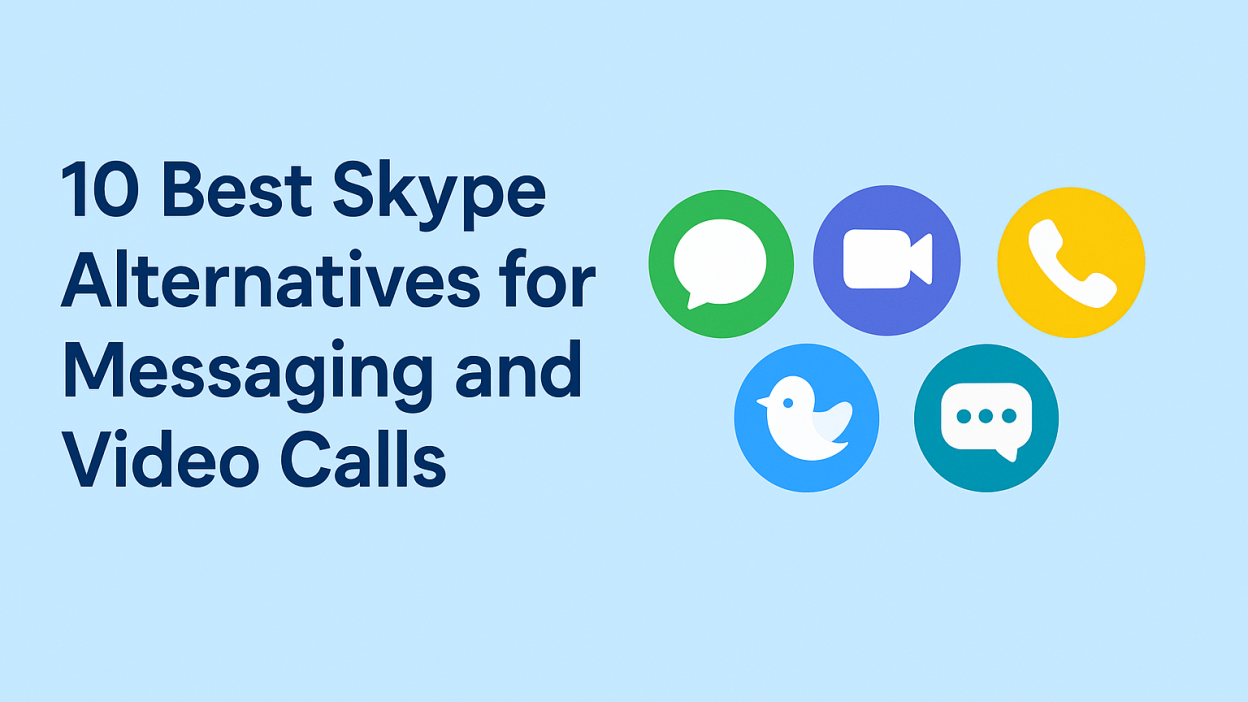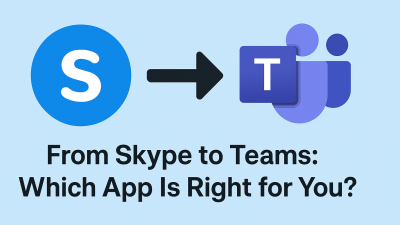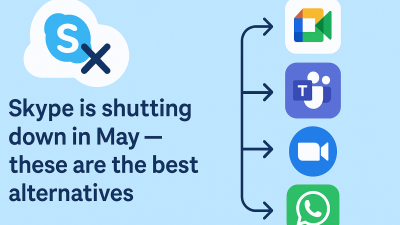Skype didn’t dominate because it had the most features. It worked because it stayed out of the way. No learning curve. No onboarding screens. Just your contacts, your calls, and your conversations — all in one place.
So now that Skype is shutting down, the question isn’t “what looks like Skype?” It’s:
“What feels effortless?”
What’s disappearing isn’t just a product; it’s a way of communicating that didn’t ask people to become power users or adapt to someone else’s workflow. It fit personal and professional life without needing a toggle.
For millions of users, Teams isn’t a natural successor. And trying to force Teams to replace Skype is like asking a conference room to act like a living room. It’s too structured, too layered, too focused on the enterprise.
That’s why this post isn’t a side-by-side spec sheet. It’s a guide to tools that let you call, message, and stay connected in ways that feel light, flexible, and real, without replacing simplicity with complexity.
When Microsoft Announced Skype’s Shutdown, It Disrupted More Than Just a Product
Skype wasn’t perfect, but it hit a rare balance: messaging and video calls, personal and professional, all in one place. It worked across platforms. It didn’t demand much. And it stayed familiar for more than a decade.
Now, users are being nudged toward Microsoft Teams. But Teams was never designed for the kind of light, fluid conversations Skype handled so well. It’s structured, feature-packed, and built with organizations in mind, not individuals trying to keep up with friends, family, or freelance clients.
So if Teams doesn’t feel right, you’re not wrong. And if you’re not interested in just replacing Skype’s logo, but preserving its purpose, this is where you start.
This post isn’t a product dump. It’s a walk-through of tools that serve the way people message, call, and connect, from one-on-one chats to full team sessions.
What You’re Trying to Replace Isn’t Skype — It’s Simplicity
Before we even get into names, it’s worth asking:
What are you trying to preserve?
For some, it’s the ability to fire off a quick message without opening a workspace.
For others, it’s the freedom to start a video call without a calendar invite.
For many, it’s about finding one tool that works across both chat and video, without pushing you into an entire productivity suite.
Most so-called alternatives don’t do both messaging and video calling equally well. That’s what made Skype rare; it worked quietly in the background, blending real-time conversation with face-to-face calls.
That’s the bar we’re using here. Not just what’s new, what’s useful.
1. MyTello – The Closest Thing to Skype’s Global Calling Simplicity
Most messaging apps today assume everyone you want to talk to is already in their system. That works if you’re chatting with friends who are always online. But if your contact is using a landline in Nairobi, a basic phone in Dhaka, or just doesn’t use apps at all, you’re stuck.
That’s where MyTello comes in.
MyTello is purpose-built for calling real phone numbers abroad, landlines or mobiles, without asking the other person to install anything or be online. It works across over 200 countries, offers transparent per-minute rates, and doesn’t require you to join a subscription plan. You pay only for what you use, and you know the rate before you hit “call.”
For anyone who used Skype primarily to stay in touch across borders, especially with non-tech-savvy family, overseas clients, or rural contacts, MyTello is a direct, dependable replacement. It doesn’t overload you with features. It focuses on the one thing Skype handled best: international calling that just works.
Where it works best:
-
Calling landlines or mobile numbers worldwide
-
Conversations that don’t rely on both users having an app
-
Replacing Skype’s classic dial-out feature with something equally simple
It’s not trying to be a team platform. It’s not trying to become your inbox. It’s just trying to help your voice reach the other side of the world — clearly, affordably, and with zero friction.
2. WhatsApp – Built for Messaging, Better Than Expected for Video
WhatsApp didn’t start as a video tool, but it’s become one of the most convenient ways to talk face-to-face, especially on mobile.
If the people you talk to are already using it, you get instant reach. Messaging is real-time, media sharing is seamless, and video calling just works — no scheduling, no setup. You open the chat, tap the icon, and you’re connected.
Where it shines:
-
Personal conversations
-
Long-distance family or friends
-
Quick transitions from chat to call
Where it struggles:
-
Desktop support is limited
-
Video call quality depends heavily on the device
-
Not ideal for professional or group settings
But if you’re replacing Skype in your personal life, and your circle already uses WhatsApp, this isn’t just convenient. It’s complete.
3. Zoom – The Gold Standard for Video, Still Catching Up on Chat
Zoom became a household name for a reason: video just works. Calls are stable, quality holds up, and it handles everything from one-on-one meetings to group sessions with dozens of people.
But as a messaging tool, Zoom still feels like an afterthought. Chats are tied to calls or meetings, and there’s no sense of persistent, ongoing conversations unless you’re deep in a team setup.
Use Zoom if video is your focus, not messaging.
What it’s perfect for:
-
Scheduled calls with clients or teams
-
Long-form conversations where face-to-face clarity matters
-
Group video sessions
Just don’t expect it to replace your everyday chat app. That’s not what it was built for — and that’s okay.
4. Signal – Stripped Down, Locked Down, and Clear
If your biggest priority is secure, distraction-free communication, Signal stands alone. It’s end-to-end encrypted by default, supports voice and video calls, and doesn’t come with bloated features or unnecessary integrations.
Messaging is fast and clean. Video calls are stable, even across devices. And there’s no advertising, no tracking, and no backdoor.
This is communication without noise.
Best for:
-
Privacy-focused users
-
People are tired of overly “smart” apps
-
Those who want clean functionality on mobile and desktop
Just keep in mind: Signal is focused. It doesn’t pretend to replace a productivity suite or offer team collaboration tools. It’s for talking — and doing it well.
5. Viber – The Quiet Contender That’s Closer to Skype Than You Think
Viber doesn’t make headlines anymore, but it quietly continues to deliver one of the closest Skype-like experiences available. It blends texting, voice, video, file sharing, and global calling — all in one interface.
You can message and call individuals or groups, create communities, and even call landlines or mobiles in other countries if you load up credit, just like Skype used to offer.
It works smoothly across mobile and desktop, and its interface stays clean even as it adds features.
Why it matters:
-
Combines casual and professional functionality
-
Works well across slow or unstable connections
-
Still supports international calls outside the app
If Skype is your go-to for keeping up with people across time zones, Viber’s worth testing before anything else.
6. Google Meet + Google Chat – Better Together, But Still Separate

Google split its communication stack into Meet (for video) and Chat (for messaging), and while each is strong on its own, the integration still feels halfway there.
Video calling through Google Meet is solid, clear, scalable, and browser-friendly. Google Chat supports threaded conversations, direct messages, and team spaces.
Together, they can do what Skype did. But it takes effort. You’ll need to switch between tabs or apps, manage invites, and rely on a connected Gmail/Workspace ecosystem to make it smooth.
Good for:
-
Teams already using Google tools
-
People are comfortable navigating multiple apps
-
Users who don’t mind adapting
Less ideal for someone who just wants one app, one place, and one-click calling.
7. Microsoft Teams – Powerful, But Not Personal
Microsoft is positioning Teams as the “official” successor to Skype. This isn’t a replacement, it’s a different product entirely.
Teams were built around the workplace structure. Every chat lives in a channel. Every call has a context. It’s not a messaging-first app, and it’s not lightweight. But if you’re part of a team that uses Microsoft 365 — or if you’re willing to shape your routine around it, Teams can combine chat, calls, and video inside a single system.
Where it works:
-
Internal team communication with structure
-
Project-based collaboration, meetings, and file sharing
-
Persistent chat threads that blend with scheduled calls
Where it doesn’t:
-
Quick check-ins or spontaneous personal calls
-
Users looking for a clean, minimal interface
-
One-to-one communication without noise
If your communication is tied to projects or documents, Teams might be useful. If you’re just trying to talk and move on — there are better fits.
8. Chanty – Underrated, Straightforward, and Actually Balanced
Chanty rarely shows up in mainstream roundups, which is surprising — because it’s one of the few platforms that does messaging and calling together without turning into a bloated workspace.
The interface is clean. You can chat in real time or in threads, share files, and switch to voice or video in seconds. It’s built for small teams, but it’s not over-engineered. You don’t need an IT background to get value from it.
What it offers:
-
Smooth transition between text and call
-
Task assignment features for freelancers or small shops
-
Audio/video that feels like a feature — not an afterthought
If you’re a solo operator, freelancer, or small team that found Skype convenient, Chanty gives you that same feeling — without dragging in unnecessary complexity.
9. Brosix – Private Networks Built for Serious Communication
Brosix isn’t aiming to be your next chat app. It’s built for teams that need closed-loop communication — think law firms, medical practices, research teams, or schools. It gives you full control over who’s in your network, how messages are stored, and what gets shared.
Messaging is clean and encrypted. Voice and video calls are available inside the private network. No ads. No algorithms. Just communication inside a boundary you control.
That matters for:
-
Teams that handle sensitive information
-
Businesses that need compliance controls
-
Users who want full transparency over data and access
You won’t find Brosix in app stores trending lists. But for focused, secure, and distraction-free communication, it holds its ground.
10. Troop Messenger – Built for Teams That Don’t Want a Manual
Some tools make you feel like you need a tutorial just to say hello. Troop Messenger isn’t one of them.
It’s aimed at small to midsize teams that need real messaging and clear calling, without setting up channels, integrations, or custom bots.
Messaging is persistent, real-time, and organized. Video and voice calls are just a click away. You also get screen sharing, remote access, and message recall — without having to configure anything special.
Why it matters:
-
You don’t need to think like a system admin to use it
-
Calls feel fast and natural, not like starting a process
-
Chats are searchable and uncluttered
If you used Skype for quick team syncs or drop-in conversations, Troop Messenger gives you a similar rhythm, just updated for today.
Choosing the Right Alternative Based on How You Communicate
Here’s where most people go wrong: they pick based on popularity, not fit. But the only way to make this transition work is to match the tool to your behavior.
If your communication is:
-
One-on-one, ongoing, cross-device → WhatsApp or Viber
-
Work-focused, task-driven, document-heavy → Teams or Chanty
-
Secure, private, distraction-free → Signal or Brosix
-
Community-driven or casual/professional blend → Discord or Troop Messenger
-
Video-first, scheduled, clean sessions → Zoom or Google Meet
Ask yourself: Do I need messaging more than calling? Do I want a scheduled structure or a spontaneous reach? Am I talking to the same group or lots of individuals?
The answers should point you toward the right tool, because no single app replaces Skype entirely. But the right one can replace what you used it for.
Final Thoughts: You’re Not Replacing a Brand — You’re Reclaiming Simplicity
Skype didn’t survive because it was trendy. It survived because it was clear. You could send a message. Make a call. Keep in touch. It asked for very little and gave you what you needed.
Most of what’s popular now asks for too much — sign-ins, schedules, setups, and integrations.
But the tools that last, the ones that feel right, are the ones that disappear once the conversation starts.
That’s your target now. Not features. Not logos. Just the clearest path between you and the people you’re talking to.




